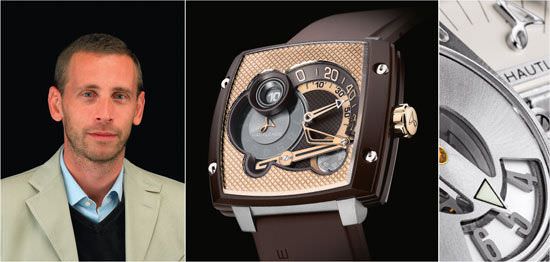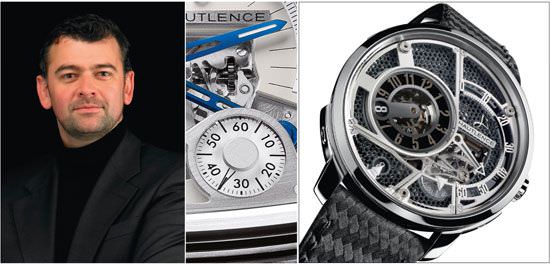Reducing fixed costs
Understanding how to control fixed costs as well as extravagant expenses is a specialty, we might say, of Alain Spinedi, the CEO of Louis Erard. For Spinedi, whose brand makes about 17,000 mechanical watches per year with very calculated prices that range from 700 Swiss francs for an entry-level steel watch to 7,000 francs for a diamond-set timepiece, even the slightest expense is important because it has immediate repercussions on the final cost of the piece. Thus, he travels only in economy class, which saves about 60,000 Swiss francs per year. If we calculate the numbers, 60,000 francs divided by 17,000 watches equals 3.5 francs per watch. “To give another example, a stand in Hall 1 at BaselWorld costs, all things considered, about one million Swiss francs, which would increase the cost of each watch by nearly 60 francs”, add Spinedi.
Alain Spinedi is building the success of his brand step-by-step on a precisely measured price/quality ratio, regardless of which segments the collections fall into. “Louis Erard is three things,” he explains. “Above all, it is the product, followed by the attractiveness of the price and finally the people, in other words, the qualitative relationships with the dis-tribution network.” In this context, while the economic downturn has harmed some markets—notably Germany that was very important for the brand—it has also offered new opportunities. “Thanks to the crisis, if I might say this,” he says with a smile, “the availability of movements is clearly greater and today I no longer have problems with supply. This has allowed me to strategically increase my product offer in the price range of 2,000 to 3,000 Swiss francs, a segment that accounts for 50 per cent of my turnover.”

Renaud de Retz and HLS00 “Clou de Paris”
Moreover, the crisis has also cracked open a number of doors. “It began much earlier,” he says, “by the rush upmarket of some brands that left the mid-range in search of the haut de gamme. This move towards the high-end created confusion for the retailers. Thus, a mid-range Brand X, for example, that was an entry-level brand in Store A, but was in the middle of the offer in Store B and at the high-end in Store C often found itself in a precarious situation in all three categories. In its move upmarket, it closed its Store C, found itself too expensive for Store B and was in awkward competition with the most prestigious brands in Store A. But for Louis Erard, these dangerous strategies, which have been hit hard by the crisis, have offered us a number of opportunities. And while it is relatively easy to move upmarket, it is much more difficult to move downmarket since the client would be totally confused.”
Necessary self-questioning
For CÉcile and Jean-Daniel Maye who, at the head of Time Avenue, manage two brands, Marvin and the Nina Ricci franchise, the different segments they work in present specific problems. But for both, “the crisis comes with the necessity to question ourselves and make radical decisions” that differ from one brand to another but that impose just as many requirements.
When Time Avenue re-launched the historic brand, Marvin, in true watchmaking style with a classic design and a sprinkling of more contemporary elements, CÉcile and Jean-Daniel Maye first went to their distribution network that carried their Nina Ricci fashion watches. They rapidly realized that watch accessories and watches crafted in the art of timekeeping belonged to two totally different worlds. They then separated the two activities and built up two distinct distribution networks, which were much more specialized for Marvin than for Nina Ricci. They also divided up the workload. CÉcile handles Marvin and Jean-Daniel takes care of Nina Ricci.

Guillaume Tetu, HL04 and HLQ02 “Honeycomb”
Obstacles
But with Marvin, even though the brand is situated in a price range totally different than the young brands in the haut de gamme sector mentioned above (Marvin’s prices range from 500 Swiss francs for an entry-level quartz watch to 3,500 francs for the brand’s most expensive mechanical timekeeper), they quickly met the same roadblocks in terms of distribution and noticed the same pressures brought to bear by the large groups. “Retailers have quotas and they have payment priorities imposed on them,” explains CÉcile Maye, “so much so that even if a new brand such as ours succeeds in being picked up by a retailer, this does not at all mean that he will sell our products. His priorities are elsewhere.”
But Marvin is “a new adventure with long-term goals, so we must hang in there. Above all, we are placing our emphasis on the product.” She compares the product to wine. “The price must not be an obstacle; rather it is a question of taste. If I were to compare us to a wine grower, I would say that we are like a small producer whose wines are excellent, bold and with character and whose prices are affordable—a wine to enjoy that does not necessarily have a famous name but an el-egant wine without snobbery. This corresponds closely to what we observe sociologically: in times of crisis, people look for pleasure in small things. They search for meaning, for something a little exclusive, certainly, but above all for something personal.”
So while waiting, Marvin is moving little by little into the marketplace, seeking to establish itself in Switzerland, in Japan where the brand seems to be appreciated for its ‘seriously light’ side, in Russia and in the Middle East, as well as in the sometimes neglected markets of Hungary and Iran.
The strategies of the independents confronted with the economic crisis: Part 1
The strategies of the independents confronted with the economic crisis: Part 2
The strategies of the independents confronted with the economic crisis: Part 3
The strategies of the independents confronted with the economic crisis: Part 5
The strategies of the independents confronted with the economic crisis: Part 6
Source: Europa Star October-November 2009 Magazine Issue





